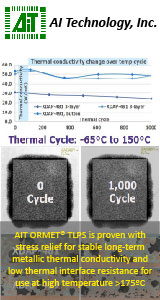|

|
|
| Ask the Experts | |||||||
|
|||||||
|
May 31, 2018 - Updated June 28, 2010 - Originally Posted Adding Weights to Small BGAs During ReflowWe have issues with small, light BGA's. They often have opens after reflow. We have no problems with larger BGA's or fine pitch BGA's with higher ball counts. Do you think it makes sense to add a weight to the top of the small BGA's during reflow to improve soldering and reduce opens? Any advice would be appreciated. C. B. |
|||||||
| Expert Panel Responses | |||||||
|
The reasons for opens with small light BGAs may be due to: a. Insufficient flux activity: For the smaller apertures and therefore a smaller paste deposit, the flux fraction burn-off is higher. Therefore the flux may not have a robust oxidation barrier to prevent the solder deposits from oxidizing and therefore cause opens - this is the Head-in-Pillow (HIP) phenomenon. Fluxes with a good oxidation barrier can prevent oxide formation and therefore prevent HIP / opens / poor solder coalescence for tiny deposits - even for long, harsh profiles b. Insufficient / Inconsistent paste volume printed: as the stencil aperture becomes smaller, it becomes more difficult to print consistent paste deposits. Low paste volume means less flux and therefore potentially not enough "juice" to withstand even a regular reflow profile. The opens you are seeing may be a Head-in-Pillow phenomenon. An optimized paste flux chemistry in conjunction to the right particle size will maximize paste transfer from the stencil to the board and eliminate opens c. Insufficient tackiness of paste: If the flux in the paste does not have enough tackiness to hold the component, then there could be loss of contact between the paste & BGA ball during reflow and opens could be caused In addition to being a cumbersome addition,a weight should really not be needed for reflowing small, light BGAs. The paste is expected to do the job of holding all components during reflow and achieve good solder joints.
Technical Manager - Europe Indium Corp. Currently with Indium Corporation and responsible for technology programs and technical support for customers in Europe. Over 15 yrs experience in SMT, Power, Thermal & Semiconductor Applications. Masters Degree in Industrial Engg, State University of New York-Binghamton.
At first this sounds a good idea but it is fraught with potential problems. What will the extra mass do to the profile, can the weights be placed without moving the part, will the weight stop the part from self centering, or compress the joints causing bridges. This sounds as if we are treating the symptom rather than the route cause. The problem from the limited description is likely a result of component warpage. What is the warpage specification on these parts? If you can't source parts with less warpage I would suggest extending the time above liquidus. If you have a good solder paste the activity will be sufficient to allow time for adjacent balls to collapse and cause contact between solder and ball.
Senior Applications Chemist Henkel Electronics Dr. Poole is a Senior Applications Chemist in Henkel Technologies, electronics assembly materials application engineering group. He is responsible for all of Henkel's assembly products including soldering products, underfills, PCB protection materials, and thermally conductive adhesives.
Be sure you understand the thermal profile of the environment under this component before you try a mechanical remedy as you have suggested. The forces that take place under the part while the solder goes to liquidus are much stronger than the weight of the part and tend to work in your favor, pulling the part into place. If there is some thermal reason for the "opens" like: too high temperature or too long at temperature, the solution may be to protect the part from the heat rather than trying to force the part closer to the board during liquidus. Of course, adding weight may have the side effect of protecting it thermally, solving the problem for the wrong reasons, so to speak. So please understand the thermal profile and its impact on the solder and its chemistry before making any changes to the assembly fixture to make sure you are solving the right problem.
Senior Project Engineer Electronic Controls Design Inc Paul been with Electronic Controls Design Inc. (ECD) in Milwaukie, Oregon for over 39 years as a Senior Project Engineer. He has seen and worked with the electronic manufacturing industry from many points of view, including: technician, engineer, manufacture, and customer. His focus has been the design and application of measurement tools used to improve manufacturing thermal processes and well as moisture sensitive component storage solutions.
You can't put the weight on the BGA at pre reflow stage. Plus the air flow in th reflow Oven and the solder paste application and PCB should be moisture Free before monting the BGA. The control on Solder Paste printing and Reflow parameter will help you to solve the BGA open Problem.
Quality Engineer Matrix Telecom Solution P Ltd Sandip Thakor has 9 years of experience in electronics industry specializing in soldering technology. Thakor has experience in lead free installation, process optimization and developing quality standards.
At first this sounds a good idea but it is fraught with potential problems. What will the extra mass do to the profile, can the weights be placed without moving the part, will the weight stop the part from self centering, or compress the joints causing bridges. This sounds as if we are treating the symptom rather than the route cause. The problem from the limited description is likely a result of component warpage. What is the warpage specification on these parts? If you can't source parts with less warpage I would suggest extending the time above liquidus. If you have a good solder paste the activity will be sufficient to allow time for adjacent balls to collapse and cause contact between solder and ball.
Senior Applications Chemist Henkel Electronics Dr. Poole is a Senior Applications Chemist in Henkel Technologies, electronics assembly materials application engineering group. He is responsible for all of Henkel's assembly products including soldering products, underfills, PCB protection materials, and thermally conductive adhesives.
Reader Comment
I would concentrate on verifying the solder paste operation is applying enough paste - consistently. You say "small BGA's" are giving you problems with opens. Are you trying to print paste with too small of apertures using too thick of a stencil? You may have to overprint or change aperture shapes to get an area ratio that releases solder paste more consistently. Had you said you were getting shorts, I would have suspected the oven profile or parts warping during reflow.
Jerry Wiatrowski, General Dynamics Mission Systems
Reader Comment
One possibility not mentioned by the experts is entrapped moisture in the parts. As moisture outgasses during reflow, the part may warp or move causing open solder joints.
David Leeper, METHODE ELECTRONICS, INC.
Try baking your parts prior to placement. Make sure you are following IPC/JEDEC J-STD-020 for handling of Moisture sensitive components. Reader Comment
Small parts mean small PCB openings. Verify that the PCB pads wet during solder reflow. Simply paste PCB (can't do flux only of course) run the reflow, and check the small pads for either no wetting or cold looking solder. Adjust profile as needed. Do at least 3 bare boards if possible.
Patrick Lavery, Vicor Corporation
You could have some anomalies in PCB fabrication that lead to pads that don't solder well 100% of the time. BGA rework is not a thing you want to do if you can avoid it and verification of PCB is the first step. If not already, look at your flux activity and reflow ramp. A hold at a preferred temperature for flux activation might be in order. |
|||||||
| Submit A Comment | |||||||
|
Comments are reviewed prior to posting. You must include your full name to have your comments posted. We will not post your email address. |
|
Free Newsletter Subscription
Circuitnet is built for professionals who bear the responsibility of looking ahead, imagining the future, and preparing for it. Insert Your Email Address |
|

|





